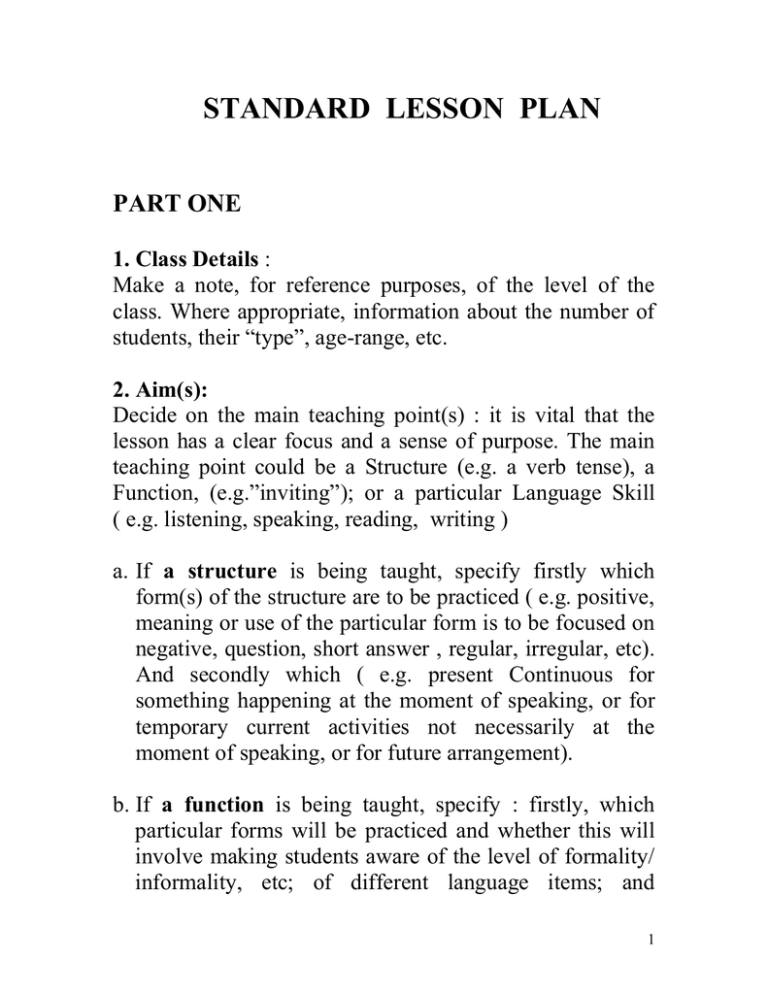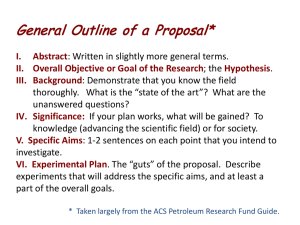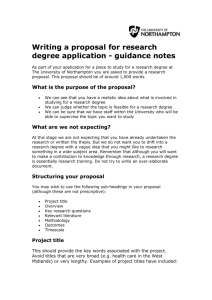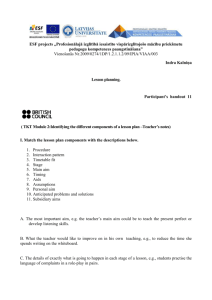STANDARD LESSON PLAN PART ONE
advertisement

STANDARD LESSON PLAN PART ONE 1. Class Details : Make a note, for reference purposes, of the level of the class. Where appropriate, information about the number of students, their “type”, age-range, etc. 2. Aim(s): Decide on the main teaching point(s) : it is vital that the lesson has a clear focus and a sense of purpose. The main teaching point could be a Structure (e.g. a verb tense), a Function, (e.g.”inviting”); or a particular Language Skill ( e.g. listening, speaking, reading, writing ) a. If a structure is being taught, specify firstly which form(s) of the structure are to be practiced ( e.g. positive, meaning or use of the particular form is to be focused on negative, question, short answer , regular, irregular, etc). And secondly which ( e.g. present Continuous for something happening at the moment of speaking, or for temporary current activities not necessarily at the moment of speaking, or for future arrangement). b. If a function is being taught, specify : firstly, which particular forms will be practiced and whether this will involve making students aware of the level of formality/ informality, etc; of different language items; and 1 secondly, if it will be necessary to teach co-functions, i.e. responses to the main function (e.g. when teaching “Inviting”, is it advisable to teach students how to accept and refuse an invitation too?) c. If a language skill is being taught, specify which particular sub-skills are to be practiced (e.g. does a “reading Lesson” practise : skimming for gist, reading for detail, making inferences from the text, guessing meaning from context, etc.). d. In all of the above cases, also decide to what extent it will be necessary to emphasize pronunciation, stress and intonation. When deciding on your aims, it will also be necessary to consider the following points : i. What should the students be able to do by the end of the lesson ? ii. Will the students feel, at the end of the lesson, that they have actually made progress and learnt something new ? On the other hand, will the lesson over-load them with new things which can only be half –assimilated (thus leading to a sense of frustration and dissatisfaction)? iii. Are your aims practically realisable, given the limitation of time, circumstance and student ability ? iv. Does the lesson connect up with what went before ? Is it building on previous learning ? 2 v. Does the lesson lead towards useful activities in later lessons ? It will be obvious from these last two points that it is necessary to do more than just plan “the next lesson”. So, PLAN AHEAD – have long term aims as well as short term aims. 3. Main language items : List the actual examples of the structural / functional points you wish to teach. For instance, your aim : to present and practice common Preposition of Place. So, in this case make a list of exactly which prepositions you intend to include : in,at,on,next to,near, between,etc; as well as the sentence structures they will be found in. Or, if you intend to teach a function such as “Making Request”, which particular ways of making requests do you intend to concentrate on: “Could you …..”,”Can you …..?”, Will you …..?”, “Would you …..?”, “I was wondering if you could possibly…..?”. And which ways of accepting / rejecting requests do you wish to practise ? 4. Materials : list any handouts, worksheets, texts, page numbers, recorded listening passages, etc that you intend to use. A quick check before the lesson will help to avoid embarrassment of forgetting something. 3 5. Aids : A checklist of teaching aids ( pictures, wordcards, realia, OHP transparencies, bluetack, etc ) which will be needed during the lesson can be very useful for reference purposes. Again, this will help you to avoid embarrassment and unnecessary interruptions to the flow of the lesson. Of course, there is no need to write down “White board” here. It is usually a good idea to plan in advance and put down on a piece of paper what your whiteboard layout is going to look like. 6. Anticipated problems : This is very useful section of the lesson plan because its existence requires the teacher to think about problems that students are likely to have during the course of the lesson: she can then build into plan ways of tackling these problems in advance, rather than coming to them completely unprepared. For example, a lesson in which a new structure / function is to be taught will commonly involve problems of: Concept : e.g. the meaning of various forms referring to the future (pres.cont, will, to be going to) Form : e.g. difficulties in forming negative and question forms, infinitive vs –ing form. Pronunciation : e.g. contracted forms, stressed vs unstressed forms. 4 Which caused by the teaching materials you wish to use : e.g. cultural background, poor layout, unfamiliar accents on a tape, etc. 00 7. Lexis / Vocabulary : It is also wise to note down word-fields (e.g. household objects) or particular keywords in the lesson. Check in the previous lesson plans if they have occurred before with this class. Will it be necessary to elicit or (pre)teach these words or expressions, and if so, what will be the most effective way of doing this ? 5 PART TWO 1. Stage : Warmer, Revision, Lead in, Pre teaching Vocabulary, Scene Setting, Elicitation, Presentation, Controlled Practice, Freer Oral Practice, production, Round up, etc. 2. Time : Estimate the approximate amount of time you think each stage will take and write down. It is clearly not easy to get the timing exactly right, particularly if you are using a piece of material or trying out an activity for the very first time, but it is important to think about it. With experience your estimates will become increasingly accurate. Remember that some kinds of activity (e.g. drilling )take longer if there are a lot of students in the class, and that a new type of activity will probably need longer instruction than one already familiar to the students. 3. Procedure : This is where you write down the details of each stage : e.g. what exactly you are going to do, what you’ll be asking the students to do, model sentences, important concept-checking and comprehension questions, cues for drilling, etc. 6 4. Interaction : Who is talking to whom ? You can develop a list of symbols ( one way, two way ) and abbreviation ( T, St, Sts, Cl,etc ). From this column you can see if there is : (a) enough STT (b) sufficient variation in the type of interaction 5. Student Activity Again, you can use abbreviations ( L,Sp,R,Wr ) to indicate the skills which the students are practicing at any given stage. It is obviously important to strike an overall balance between the four skills. 6. Materials / Aids : Make a note of any materials / aids that will be introduced at any particular stage. Make sure that any sets of worksheets are in the correct order so that they can be easily found at the right moment. 7. Notes : As soon as possible after the lesson (While what happened is still fresh in your mind ) write comments on the success or otherwise of the different phases of the lesson and of the lesson as a whole (giving reasons for any lack of success, if possible). Note down any unexpected problems that arose and any big differences between projected timing and actual timing. Also note down any brilliant ideas you had during the lesson or any successful spontaneous 7 activities that you were able to introduce ( perhaps because of something a students said ). All of this will improve the quality of your lesson the next time you tackle that particular language-point or those particular materials 8


